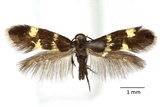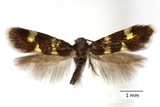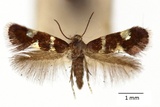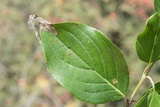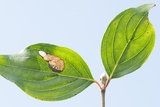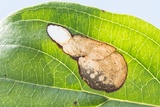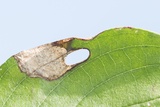Antispila treitschkiella (Fischer von Röslerstamm, 1843) Species
Last modified: Jan. 9, 2024, 4:14 p.m.
This species is not so common in Belgium and was – initially based on DNA investigations – separated form Antispila petryi in 2018. The latter is also a larger species, shows some differences in larval and genitalic morphology and has another hostplant.
Details
- Classification
- Family: Heliozelidae > Genus: Antispila > Species: Antispila treitschkiella
- Vernacular names
- Kleine kornoeljegaatjesmaker (NL), Cherry Lift (EN), Kornelkirschen-Erzglanzfalter (DE)
- First mention in Belgium
- Fologne E. 1860. Lépidoptères et chenilles observés en Belgique. — Annales de la Société entomologique belge 4: 108–112. On page 109 (as Elachista Treitschkiella. Mn.). view page
- Status
-
Native
Distribution
Mine
The mine initially starts as a short gallery of about 10 mm, containing a lot of frass. This gallery is often somewhat wrinkled and follows, in general, the leaf margin rather closely. Later on, it becomes a full depth blotch mine that can reach a diameter of several cm and in which the frass consists of scattered grains. Eventually, an oval blotch section of 4 to 5 mm with a glassine paper-like layer of silk is spun and subsequently cut loose.
See also bladmineerders.be
Bionomics
Ovipositing usually happens close to the leaf margin. The young larva constructs from there a short gallery of about 10 mm, containing a lot of frass. This gallery is often somewhat wrinkled and follows, in general, the leaf margin rather closely. After moulting, the gallery leaves the margin of the leaf and a full depth blotch – that can reach a diameter of several cm – is constructed by the larva. The frass in this blotch consists of scattered grains. Once full-grown, the larva covers an oval blotch section of 4 to 5 mm with a glassine paper-like layer of silk, cuts this loose and crawls (or falls) inside this case towards the soil. The larva also hibernates inside this case on or just below ground surface and pupates next spring.
The moths are active in sunshine.
Flight periods
The adults fly in two generations a year: May–June and again from August till the end of October. It is possible generations overlap.
Observed on
- Host plant (species):
- Cornus mas
- Host plant (genera):
- Cornus
The larva feeds monophagously on Cornus mas.
